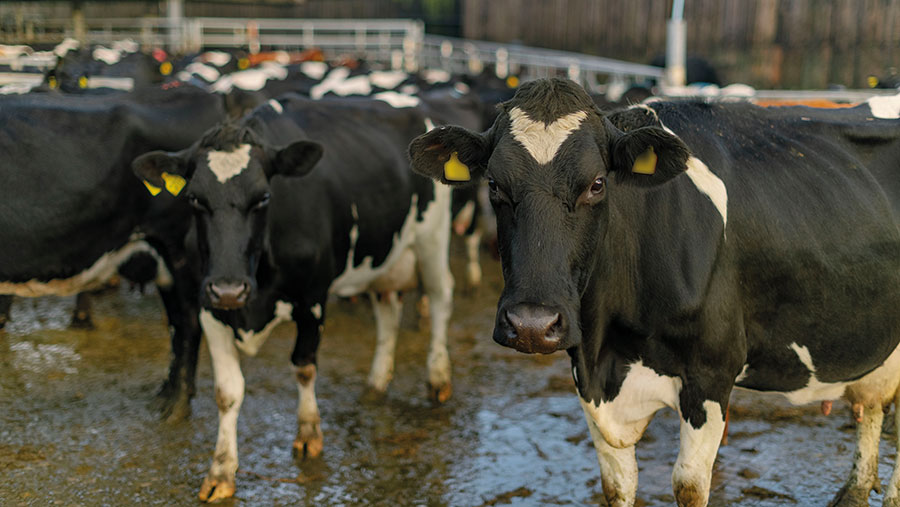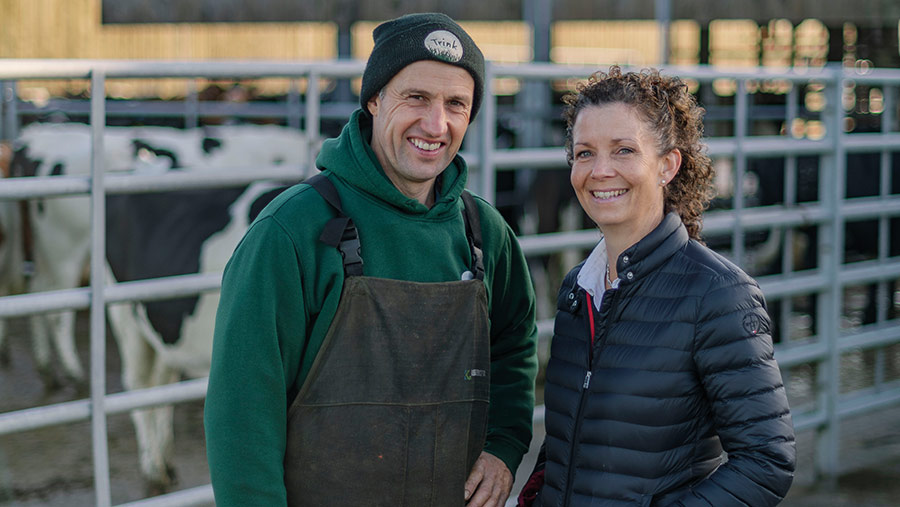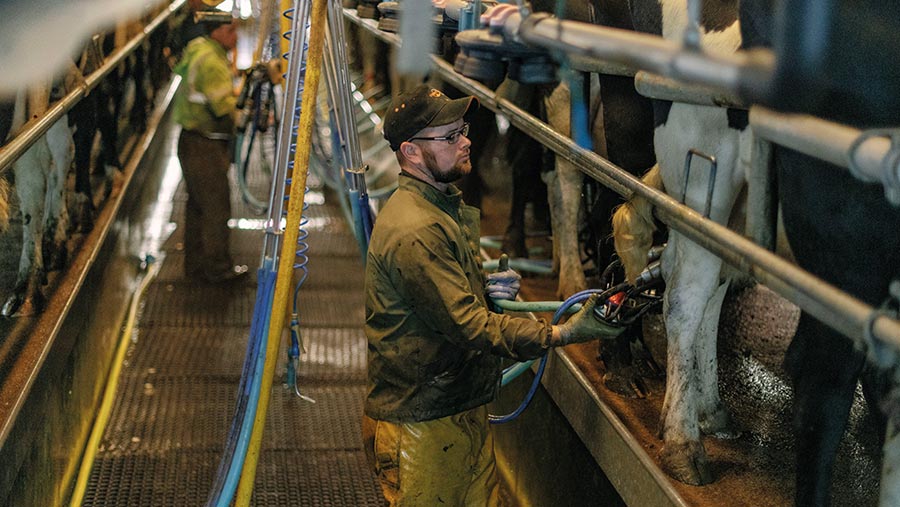A dairy farmer’s tips on switching to once-a-day milking
 Trink Dairy herd © Jim Wileman
Trink Dairy herd © Jim Wileman Higher-value milk and less stress for cows and people are two reasons Chris and Rachel Knowles know they made the right decision moving to once-a-day milking on their Cornish dairy.
Since swapping the whole herd from twice to once-a-day (OAD) milking in 2019, milk output has dropped 18%, but combined fat and protein has climbed from 8.2% to 9.1%.
This has helped support at least a 10% uplift in milk price.
At the same time, this high-solids product, together with the positive messages around grass-based dairying, proves an attractive selling point for their milk, about 8% of which is bottled and sold under the Trink Dairy brand.
See also: How once-a-day milking can be as profitable as twice
Farm Facts: Trink Dairy, St Ives, Cornwall
- 223ha (550 acres)
- 350 cows – 75% Friesian and 25% Friesian cross Jerseys
- Spring block calving – mid-February to mid-April
- 4,100 litres a cow a year at 5.1% fat and 4% protein
- Supplying Arla
- About 8-9% of milk bottled and sold to coffee shops, farm shops and via doorstep deliveries
- Herd is rotationally grazed and fed to yield in parlour. Buffer fed at shoulders of the year or when grass growth dips
- 180,000 cells/ml average bulk somatic cell count
- 10 cases of mastitis per 100 cows
- Sexed and beef breeding strategy
The Knowles made the decision to reduce milking frequency in 2018. Initially, they chose to move 80 cows to OAD as a trial.
In doing so, they hoped to better utilise a 25ha (61.75-acre) block of grazing located about 1.5 miles from the dairy. On twice a day, accessing this block was proving time-consuming for both cows and staff.

Chris and Rachel Knowles © Jim Wileman
OAD also fitted with the business’s ethos of running a simple, sustainable system while also proving more attractive should the Knowles’ daughters choose to join the business.
Seasonality was also a big factor. On twice-a-day milking, a lot of milk was produced in April-June when the milk price drops.
By moving to OAD, cows’ peak milk production is lower and relatively more milk is produced at the end of the summer when seasonality is not an issue.
Mr Knowles says this equates to about a 12p/litre swing on B litre value.
He explains: “You tend to send less as a percentage of total production on once a day at the start of the season when you’re being penalised so heavily.
“When you couple that with the other costs you save, in terms of the second milking and feeding half the concentrate, and you add in the other, smaller savings, like electricity and dairy chemicals, the gap between profitability on twice and once a day becomes quite small.”

The milking parlour at Trink Dairy © Jim Wileman
In 2019 the Knowles made the decision to move the whole herd to OAD.
Some of the lessons Mr Knowles learned include:
1. Take a long-term view
Milk production dropped by 30% in the first year when all cows moved to OAD, compared with twice a day.
It subsequently climbed and is currently 18% less than when cows were milked twice daily. Mr Knowles is now working to improve this through breeding and selective culling.
His aim is to be down 15% on production versus twice-a-day milking.
“You’ve got to look at it in the long term. For me, it’s all part of your ethos and how you view your farm and its output,” he explains.
2. Heifers tend to be affected more
Heifers tend to give less on OAD versus cows. For example, a heifer expected to give 5,000 litres on twice-a-day milking may give only 3,000 litres on OAD.
The comparable figures for a cow might be 5,000 litres and 4,000 litres. With that in mind, Mr Knowles says it’s worth carrying a maximum of 20% heifers on OAD.
3. It won’t suit all cows
There will be some cows that don’t suit OAD. In the first year, Mr Knowles culled about 5% of the herd because they were unsuitable.
These were largely high somatic cell count individuals and animals that gave uneconomical amounts of milk and went fat.
Mr Knowles adds: “You can’t get away with carrying the older, high somatic cell count cow as her somatic cell counts will be exaggerated on once a day.”
4. Cows carry more condition
Cows tend to carry about half a body condition score more during lactation.
Mr Knowles says: “I feel that’s a positive in terms of fertility, in terms of immunity; they’ve just got a bit more resistance to whatever might come along, like the weather.
“They’re able to weather the weather and any health pressures.”
Mr Knowles acknowledges the herd is about 5% less profitable on OAD as he hasn’t been able to reduce costs to the extent that they match the reduction in production.
He acknowledges that he could reduce costs more by making labour savings. He has stopped using relief milkers but has chosen to retain two full-time members of staff to create a more sustainable and attractive business for the future.
“If you’ve kept things like-for-like in terms of labour structure, you’ve got to make a bit less money or everyone would do it,” he says.
“It’s potentially a bit less profitable, but if you can accept that and have a better lifestyle, it’s worth it.”
Key considerations
LIC Pasture to Profit consultant Piers Badnell says cost control is essential on OAD systems to ensure maximum profitability.
“On once a day, fundamentally you’ve got to be good at cost control. If you drop 20% of production, you’ve got to save that elsewhere,” he says.
This means grazing for as long as possible to minimise the housing period.
New slurry storage regulations coming into effect in Wales could also create challenges for some OAD milking systems.
As part of the Water Resources (Control of Agricultural Pollution) (Wales) Regulations 2021, from 1 August 2024, Welsh cattle farmers must have five months of slurry storage.
David Ball, senior relationship manager, Resilience Fund, for AHDB, says lower-output systems like OAD will find it harder to finance higher investment such as slurry storage. He believes the rule change brings into focus the importance of optimising a OAD system so overhead costs match the lower output.
On OAD systems in high rainfall areas, where costs are higher because of longer housing periods, the new storage requirements could create bigger challenges.
Mr Ball says this highlights the need to ensure that system type is matched to location.
